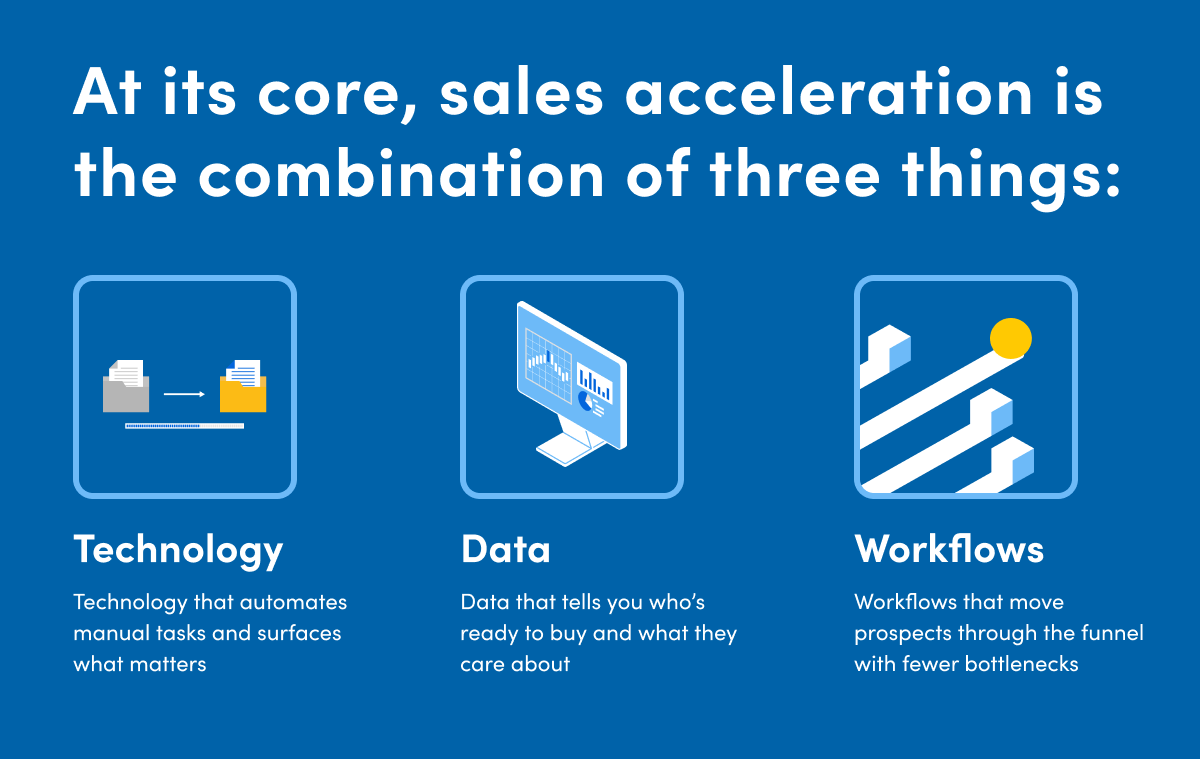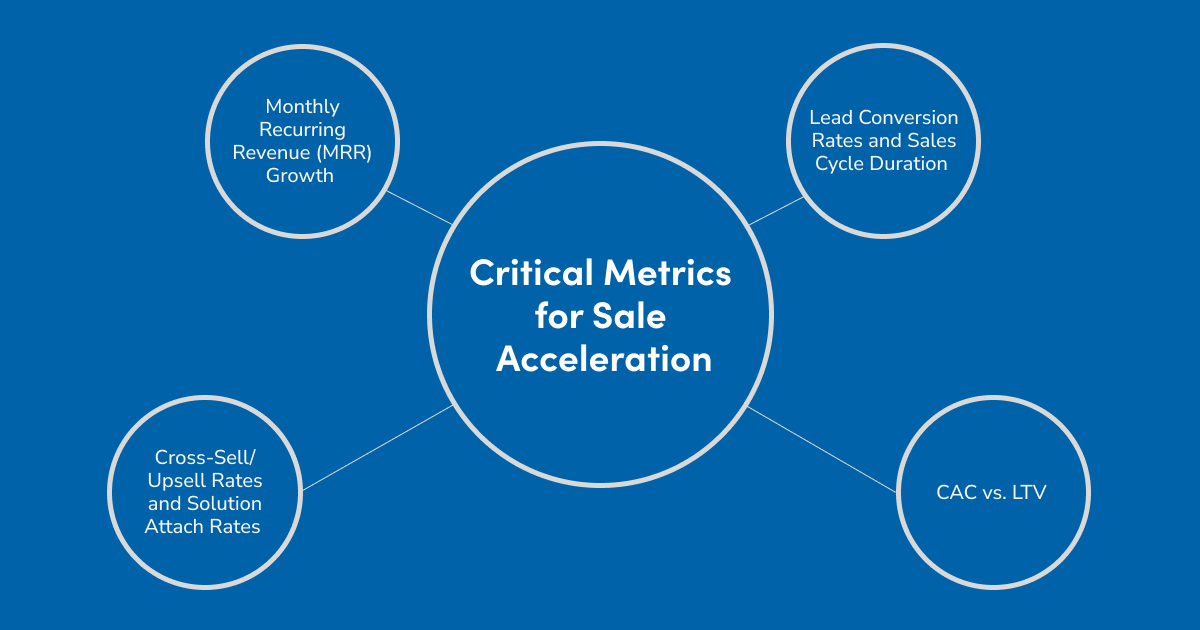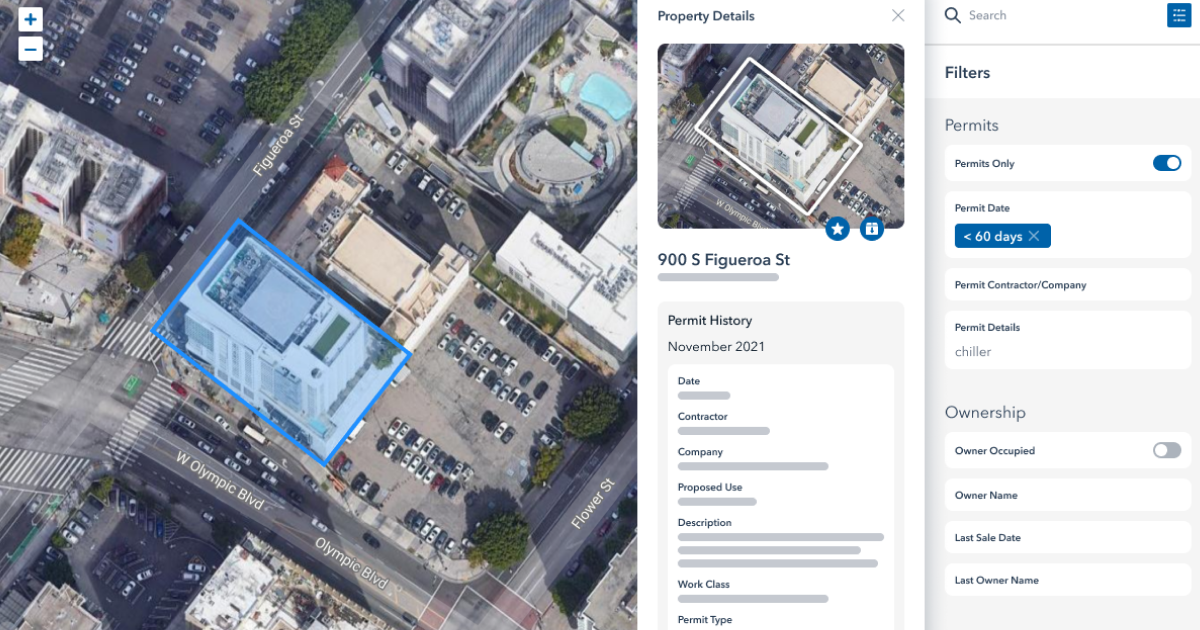Introduction
If you're in sales at any level, you've probably already felt the pressure to grow faster with less. That means finding more prospects, closing more deals, and doing it all with less people, fewer tools, and lower budgets.
With market instability, increased competition, and ever-evolving technology, the need for sales acceleration has become more pressing than ever. The world of commercial services sales is speeding up. But if your strategy hasn’t caught up, it’s easy to get left behind.
Sales acceleration isn’t just a buzzword—it’s a strategy that was created in response to the rapidly evolving marketplace. In 2025, sales acceleration strategies are shifting the way commercial contractors and service businesses generate leads, build pipeline, and close deals by using data, automation, and artificial intelligence to reshape customer expectations.
In this article, we’ll walk through how each specific shift could accelerate your sales pipelines and how your team can use modern technology to turn lagging growth into a predictable engine for revenue.
Understanding the Challenges Facing Commercial Services Sales

Limitations of Traditional Sales Methods
In commercial services sales, primarily HVAC, roofing, janitorial, and solar, the old ways of selling - driving for dollars, cold calling from outdated lead lists, and relying on referrals - just aren’t scalable. The hit-or-miss nature of traditional prospecting leaves too much to chance and often requires more time than it's worth.
Sales reps spend hours trying to figure out which properties to go after, who the decision-maker is, and whether there’s even a need for them to fill. That’s time they’re not building relationships or closing deals.
In crowded markets, even great service isn’t enough to stand out anymore. Without an in-depth understanding of what differentiates you from all of your competitors, your services become commoditized, and you become one of a dozen vendors knocking on the same door, selling the same thing.
This requires access to the right data, without which, you’re flying blind (something we'll talk about in a minute).
Integration Hurdles Impacting Sales Efficiency
But let’s say your team actually finds a great lead, then what?
For many commercial contractors, the tech stack is a mess: lead data is scattered across multiple spreadsheets, outreach relies on a mix of disconnected tools, and frequent team turnover leaves CRM data outdated and ineffective. According to Bain & Company, 70% of businesses struggle to integrate their sales plays into their CRM and revenue technologies (Bain & Company).
That friction slows everything down. Disconnected tools lead to duplicate work, inconsistent follow-up, and missed opportunities.
To grow your business in 2025, your team needs more than hustle. You need a system that works at scale.
What is Sales Acceleration? A Simple Explanation

Sales acceleration is all about helping your team go from first contact to closed deal—faster, smarter, and more predictably.
It’s not just about working harder. It’s about building a system that removes the friction in your sales process. That means cutting out wasted research time, avoiding dead-end leads, and giving reps the tools to have better conversations from day one.
At its core, sales acceleration is the combination of three things:
Technology that automates manual tasks and surfaces what matters
Data that tells you who’s ready to buy and what they care about
Workflows that move prospects through the funnel with fewer bottlenecks
In practical terms, this could look like:
Identifying high-intent buyers actively searching for your services
Identifying high-value commercial buildings with recent permit activity
Using AI to create personalized outreach emails, phone call scripts, and video messages
Scheduled or Automated follow-ups so no opportunity slips through the cracks
If you’ve ever felt like your sales process takes too long or burns too many hours chasing the wrong leads, sales acceleration is how you fix that. It’s the system behind faster cycles, stronger pipelines, and more wins—without hiring five more reps.
Accelerating Sales Through AI-Driven Automation
Transforming Lead Generation and Qualification
Sales acceleration starts with targeting the right buildings at the right time.
AI-powered tools like Convex’s Signals allow your team to spot buying intent by looking at web behavior that shows who's in the market for your services. When you pair this with sales intelligence data—detailed contact information for property owners, managers, facilities staff, and engineers—alongside property intelligence data, including building type, age, square footage, occupant details, permit history, and property updates, you gain a powerful combination of insights. Instead of chasing cold leads, your team focuses only on accounts most likely to convert.
The result? Faster qualification, fewer dead ends, and a sales team that’s working smarter, not just harder.
Automating Sales Tasks for Increased Productivity
Manual quoting. Proposal writing. CRM updates. Follow-ups.
Each step is critical to a sale, but they eat up time. With AI-driven tools and automation, your team can generate custom proposals, follow-up emails, and call scripts in minutes, not hours. In fact, teams that combine Convex and Aspire have increased their win rates by 12-15% according to one case study. And, using automations like this can give sales teams up to a 50% boost in productivity simply by automating repetitive sales tasks (QuickCreator).
Which brings us to our next point...
Enhancing Sales Enablement with AI
AI isn’t just for automation—it’s also a coach, can draft scripts, analyze sales metrics, and do so much more. This is obviously a far bigger topic than we have time to cover today, but AI is one generation away from completely revolutionizing sales.
Recently, in conversations with solopreneurs in electrical and plumbing, AI assistants, calling tools, and other AI-powered sales tools are already empowering one-person businesses to compete with larger companies.
With the increasing use of AI in sales, it's important for businesses to embrace this technology and integrate it into their sales processes.
One way AI can be utilized for sales enablement is through lead scoring. AI algorithms can analyze customer data and behavior patterns to identify potential leads with a high likelihood of conversion. At Convex, we call this "signal strength," and it helps sales teams prioritize their efforts on leads that are most likely to convert.
But another way is training Generative AI on building data, job titles, and company history so your sales and business development reps get personalized messaging for every outreach. Instead of “Hey, just checking in,” they’re sending hyper-relevant insights that break through the noise and earn attention.
With AI, sales enablement becomes more dynamic, adapting in real time to genuine market signals. (G2 Learn).
Hyper-Personalization: Driving Authentic Customer Engagement
Dynamic Content Customization
Imagine seeing a generic sales outreach email that says:
Subject: Exciting Opportunity for you...
Email: Hello! I wanted to reach out and introduce myself as a trusted partner in HVAC solutions. At XYZ Enterprise Inc., we are proud to offer state-of-the-art heating, ventilation, and cooling systems designed to revolutionize your workspace environment.
We believe your building could really benefit from a brand-new HVAC unit—even if your current system is still working. We’re currently offering an exclusive promotion for qualified businesses like yours!
Please don’t hesitate to reach out if you have any questions about this exciting opportunity to transform your airflow.
Let us help you reach your HVAC goals.
Thank you,
XYZ Sales Rep
You'd probably immediately mark it as junk or reply with a simple "please don't email me again." Now, this may be a slightly comical example, but this type of generic outreach is hitting inboxes a hundred times a day, and people wonder why it doesn't get results.
Now, imagine a sales email that references the age of a rooftop unit, mentions the square footage of the property, and highlights how similar buildings in the area saved on energy costs. It might look something like:
Subject: [Person], saw your rooftop unit’s approaching 18 yrs old—worth a quick look?
Email: Hi [First Name],
I was reviewing HVAC data on Chicago commercial buildings and noticed your property at [Property Address]—specifically, the 18-year-old rooftop unit servicing the 72,000 sq. ft. facility was getting close to its next service.
Other engineers we’ve worked with in similar buildings (e.g., [Nearby Facility Name], [Property Type]) saw up to a 22% reduction in energy costs after integrating BAS with their existing HVAC setup, without a full system replacement.
If you’re currently exploring ways to cut utility spend or streamline your energy management, I’d be happy to share what worked for them and walk you through options that align with your building’s lifecycle and operational goals.
Would a quick 15-minute call next week be worth it?
Best regards,
[Your Name]
That’s the power of dynamic content driven by data.
Personalized outreach cuts through spam filters, the noise from other companies' sales messages, and shows your prospect you’ve done the homework. For commercial services, that level of relevance is the difference between a reply and a delete.
Data-Driven Decision Making and Predictive Analytics
Predictive analytics helps your team stop guessing and start acting with confidence. Whether it’s identifying seasonal service needs or spotting signs that a contract is up for renewal, advanced insights put you one step ahead of the competition.
And when you use that insight to tailor your pitch, you’re not just selling—you’re solving a problem (DeltaRevenue).
Leveraging B2C Insights for B2B Commercial Services Sales
B2C tools like Amazon.com have changed buyers' expectations. Now, B2B buyers want the same: speed, transparency, and ease.
For commercial contractors, that means making it easy to get a quote, offering online scheduling, and sending personalized recommendations. This is far from the one-size-fits-all sales decks we're all used to.
Remember: The more friction you remove, the more likely your buyer is to say, “Yes.”
Optimizing Revenue Models for Growth
Embracing Recurring Revenue Models to Increase LTV
Customer Lifetime Value (CLTV or LTV) is the total revenue you can expect from a customer over the course of the relationship. Once you calculate how much it costs to acquire a customer (CAC), you can compare the two to understand if your business is built for growth or just breaking even.
A strong CAC-to-LTV ratio (typically 3:1 or better) tells you that your team isn’t just landing deals—they’re landing the right kinds of customers: the ones who stick around, buy more over time, and generate predictable revenue.
And that’s where recurring revenue models come in.
One-off installs or deep cleaning are fine, but real growth happens with repeatable, contracted services.
Whether it’s preventative HVAC maintenance, recurring janitorial schedules, or bundled seasonal property services, subscription-style agreements increase LTV, stabilize cash flow, and open the door to long-term client partnerships.
The key? Deliver consistent value, and back it up with data. When you can show cost savings, energy efficiency gains, or reduced downtime, you earn trust—and a contract that all but renews itself.
Effective Portfolio- and Insight-Led Sales Motions
As an addition to the previous point, rather than pitching a single service, bundle your offerings around a customer’s specific building needs.
Using Atlas property intelligence, your reps can propose bundled services tailored to building type, usage, and lifecycle stage. That’s not just smart—it’s strategic. It makes purchasing easier and positions your company as a long-term partner, not just another vendor.
Strategic Partnerships and Channel Optimization

Leveraging Partner-Led Demand Generation
Your best leads might not come from your own list.
This is a hard pill to swallow, but it can rapidly accelerate sales if you approach it in the right way.
Co-marketing with suppliers, distributors, or related service providers opens new doors because it expands your proverbial net beyond your own audience.
Think: a roofing contractor co-marketing with a solar installer. Together, you can nurture demand and share insights that benefit both teams.
Partner-led demand gen is something technology companies have been using for over a decade to accelerate demand and increase lead flow. When you align around a shared lead generation strategy, conversion rates go up.
So, how do you actually make this work in commercial services?
Start simple. Reach out to a trusted partner—someone upstream or downstream from your service. For example, if you’re in janitorial, think about commercial painting, fire safety, or building management system vendors. If you’re in HVAC, reach out to manufacturers, building automation specialists, or energy auditors.
From there, co-create something useful:
A joint case study or maintenance guide
A bundled seasonal service offer
An invite-only lunch-and-learn for property owners and managers in your area
The goal isn’t to pitch together—it’s to create value together. Share leads when relevant, refer when appropriate, and build a system where both teams win.
As the old saying goes, "If you want to go fast, go alone; if you want to go far, go together."
It’s not just collaboration. It’s shared pipeline acceleration—something commercial services teams have been missing for far too long.
Maximizing Marketplaces and Ecosystems
Don’t overlook third-party ecosystems like industry publications, vendor directories, procurement portals, or cloud marketplaces. For many commercial buyers, these are the first places they look when seeking a new vendor.
Participate. Optimize your listings. And make it easy to reach out.
Accelerating Sales Through Streamlined Closing Techniques
Faster Proposal and Pricing Strategies
When closing deals, speed matters (within reason). How many times have we missed a quarterly quota because a deal closed one week after we finalized our numbers?
This is where automated quoting and estimate tools, like those built into Aspire, allow your reps to turn a sales outreach or walkthrough into a ready-to-send proposal before they even leave the parking lot (sometimes before they even step foot on it).
With clear pricing models and fast follow-up, you’re the easiest vendor to buy from—and that’s often the difference-maker.
Demonstrating Value Through Case Studies and Proof-of-Value
According to Zippia, the average person sees between 4,000 & 10,000 ads per day. But today, buyers want proof, not promises.
Case studies that highlight savings, improvements, or resolved pain points help your prospect visualize results. Use storytelling—not spreadsheets—to show how similar clients achieved success.
Here's an example from one of our own commercial services clients - see how Comfort Systems USA Southwest used Convex to double their pipeline and grow faster.
Client Account Expansion and Retention
Structured Cross-Sell and Upsell Frameworks
Teaching your team “upselling” and “cross-selling” is one of the fastest ways to accelerate revenue. If one in every two buyers adds a service plan or bundle to their existing agreement, you could easily double the lifetime value of a customer.
But that doesn't change the fact that your existing customers are your fastest path to growth.
If your CRM includes artificial intelligence analytical tools, use AI to analyze service history and identify what comes next: a roof that’s nearing replacement, an HVAC unit that’s due for maintenance, or a tenant change that signals a cleaning opportunity.
Then enable your reps with playbooks that guide conversations and offer upsells that actually make sense.
Enhancing Customer Lifetime Value
I know we keep hammering the idea of lifetime value, but it's truly one of the fastest ways to grow your business.
A clean handoff between sales and service, proactive check-ins, and value-added insights (like permit tracking or energy savings reports) go a long way.
When you treat every renewal like a value-driven conversation with upsells and cross-sells—backed by data and outcomes—you create loyalty that lasts.
Measuring Success: Critical Metrics for Sales Acceleration

If you can’t measure it, you can’t improve it.
Monthly Recurring Revenue (MRR) Growth shows whether your new go-to-market model is gaining traction.
Lead Conversion Rates and Sales Cycle Duration indicate how well your sales acceleration efforts are working.
Cross-Sell/Upsell Rates and Solution Attach Rates point to how well you’re expanding accounts.
And CAC vs. LTV tells you if you’re building something sustainable.
These aren’t just numbers—they’re how you win next quarter. But how do you actually track and use these numbers?
Start by tying each key metric to a real activity your team does every week. Here’s how to break it down:
1. Monthly Recurring Revenue (MRR) Growth
Track the total monthly revenue from recurring service contracts.
How to measure it: Use your billing system or CRM to pull recurring revenue only (exclude one-off jobs).
Why it matters: If MRR is flat, you’re likely relying too heavily on new installs instead of building long-term customer value
2. Lead Conversion Rates + Sales Cycle Duration
Measure how many qualified leads turn into closed deals, and how long it takes.
How to measure it: In your CRM, track lead source, stage changes, and deal close dates.
Why it matters: High-quality leads convert faster. If deals are dragging, you may be wasting time on the wrong prospects—or missing signals to re-engage.
3. Cross-Sell / Upsell Rates + Solution Attach Rates
These show whether reps are expanding accounts or just landing initial business.
How to measure it: Review deals where multiple services were sold (e.g., janitorial + floor care). Tag expansion opportunities in your CRM.
Why it matters: If reps aren’t attaching more than one service, you’re leaving money (and relationships) on the table.
4. CAC vs. LTV
Compare what it costs to acquire a customer vs. what they’re worth over time.
How to measure it:
CAC: Add up sales + marketing costs for a time period, and divide by the number of new customers acquired.
LTV: Average contract value × average customer lifespan × gross margin. Why it matters: If you’re spending $5K to win a customer who only generates $6K in total revenue, it’s time to rethink your offer, pricing, or retention strategy.
Once you have these metrics in place, review them monthly (or quarterly) with your team. Ask:
Where are we winning faster than expected?
What’s dragging—and why?
Where can we double down?
Sales acceleration isn’t about guesswork. It’s about turning insight into action—and making your revenue engine run smoother every quarter.
Looking Ahead: Adopting and Implementing Effective Acceleration Strategies
The most important thing you can do right now? Start today.
Pick one tool to integrate, one workflow to streamline, one integration to fix or one segment to target with better insights.
Start small, measure progress, and scale what works. As you prove out repeatable wins, expand your sales acceleration strategy across teams and territories.
And remember - your tech should empower your people - not replace them. Equip your team with tools they’ll actually use, training they’ll benefit from, and workflows that align with how they work.
Because acceleration doesn’t come from software alone—it comes from strategy.
Conclusion
Creating a Sales acceleration plan for your business in 2025 isn’t about hustle. It’s about precision, speed, and personalization.
By embracing AI-driven automation, sales intelligence, property intelligence, and recurring revenue models, commercial services companies can build scalable, efficient, and winning sales teams.
Want to see how? Schedule a free demo to see Convex in action.
Share





